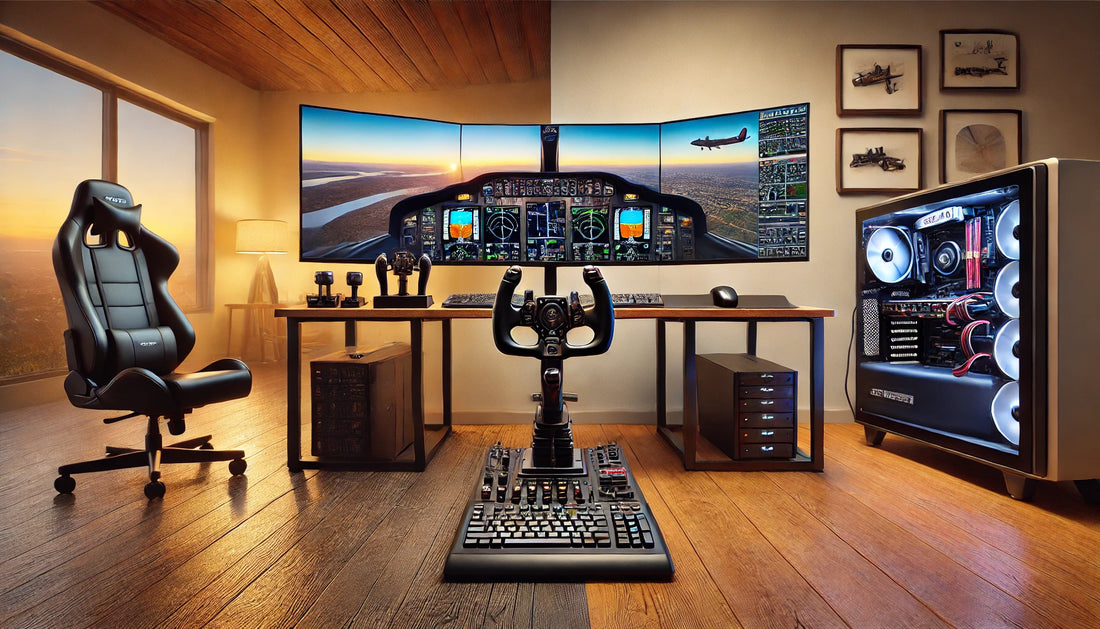
Flight Sim Gear vs. Standard Hardware: What Makes the Difference?
Share
When diving into the world of flight simulation, one of the biggest decisions you’ll face is choosing between dedicated flight sim gear and standard computer hardware. While it’s possible to fly with basic equipment like a keyboard, mouse, and standard joystick, there’s a reason flight enthusiasts invest in specialized gear. But what exactly makes the difference, and is it worth the upgrade? Let’s explore the key distinctions and how each setup impacts your flight simulation experience.
The Basics of Standard Hardware for Flight Sims
For those just starting, standard computer hardware can be a good entry point. A keyboard and mouse handle basic inputs, while a standard joystick or game controller can add some level of precision. However, there are limitations to this setup:
- Keyboard and Mouse: While sufficient for menu navigation, they lack the tactile feedback and realism required for smooth control during takeoff, landing, or complex maneuvers.
- Basic Joysticks: These offer better control than a keyboard but often lack the buttons and axes necessary to mimic real aircraft systems.
For casual users, this setup may suffice. But for enthusiasts looking for immersion and precision, standard hardware quickly reveals its shortcomings.
What Flight Sim Gear Brings to the Table
Dedicated flight sim gear is designed to replicate the experience of flying a real aircraft. From tactile feedback to customizable inputs, it elevates the simulation experience in several ways:
1. Realistic Controls and Feedback
Flight sim gear such as yokes, throttles, and rudder pedals mimic the feel and response of real aircraft controls. A yoke like the Honeycomb Alpha allows for smooth, realistic pitch and roll adjustments, while rudder pedals replicate the subtle footwork required for coordinated turns and crosswind landings.
Why It Matters: The tactile feedback enhances muscle memory, making it an invaluable tool for training and realism.
2. Multiple Axis Control
Standard joysticks often have limited axes, restricting your ability to control complex maneuvers. Dedicated gear, like throttle quadrants, provides multiple axes for managing throttle, mixture, and propeller settings independently.
Why It Matters: This is especially important for multi-engine aircraft or when flying under advanced conditions like engine-out procedures.
3. Button Customization and Accessibility
Flight sim peripherals often come with customizable buttons and switches, allowing you to map complex commands like gear deployment, autopilot adjustments, and radio tuning. For example, the Logitech Flight Switch Panel provides easy access to critical systems at the push of a button.
Why It Matters: Reducing reliance on keyboard shortcuts lets you focus on flying, not fumbling through menus.
4. Immersion and Visual Experience
Specialized gear like the FlightSimBuilder G1000 offers high-resolution displays that replicate real-world avionics. Coupled with VR headsets or multi-monitor setups, these devices transform a simple desk into a virtual cockpit.
Why It Matters: Seeing and interacting with controls just as you would in a real aircraft enhances situational awareness and makes flying more intuitive.
Comparing Performance: Standard Hardware vs. Flight Sim Gear
|
Feature |
Standard Hardware |
Dedicated Flight Sim Gear |
|
Control Precision |
Limited |
High |
|
Realism |
Minimal |
Exceptional |
|
Immersion |
Low |
High |
|
Tactile Feedback |
None |
Realistic |
|
Complex Commands |
Requires keyboard shortcuts |
Customizable controls for efficiency |
|
Cost |
Affordable |
Moderate to High |
When Does Flight Sim Gear Make Sense?
Not every flight sim enthusiast needs to invest in dedicated gear right away. Here’s how to decide:
Stick with Standard Hardware If:
- You’re new to flight simulation and want to test the waters without a large financial commitment.
- You use the simulator casually for scenic flying rather than for precise control or training.
- You’re satisfied with basic joystick input and don’t require advanced features.
Invest in Flight Sim Gear If:
- You’re serious about realism and immersion.
- You’re practicing advanced flight techniques or working toward a pilot’s license.
- You want to simulate specific aircraft, such as multi-engine planes or glass-cockpit-equipped models.
The Role of Training and Realism
For those training for real-world aviation, dedicated flight sim gear isn’t just a luxury—it’s an essential tool. For example:
- Practicing Landings: A yoke and rudder pedals allow for fine-tuned adjustments during the final approach, mimicking the experience of a real cockpit.
- Instrument Training: Replicas like the FlightSimBuilder G1000 help pilots familiarize themselves with avionics, reducing learning curves during actual flights.
- Emergency Scenarios: Simulating engine failures or crosswind landings is much more realistic with specialized controls.
Cost vs. Value: Is It Worth the Investment?
While flight sim gear can be pricey, it’s important to consider the long-term value. A high-quality setup not only enhances your enjoyment but also serves as a training tool, potentially saving money on actual flight lessons. Additionally, many peripherals are built to last, making them a worthwhile investment for enthusiasts.
Budget Tip: Start with one or two key components, like a yoke and throttle quadrant, and gradually expand your setup as you gain experience.
What About Compatibility?
One of the advantages of dedicated flight sim gear is its seamless compatibility with popular simulation platforms like Microsoft Flight Simulator, X-Plane, and Prepar3D. Many devices come with plug-and-play functionality, allowing you to start flying right away.
Pro Tip: Always check for driver updates and calibration tools to ensure optimal performance from your gear.
Conclusion: The Difference Is in the Details
The choice between standard hardware and dedicated flight sim gear ultimately depends on your goals and budget. While standard hardware can get you started, flight sim gear opens the door to a more realistic and immersive experience. From precise control inputs to advanced customization options, the difference is clear when you upgrade.
If you’re ready to take your flight simulation setup to the next level, explore the range of high-quality flight sim gear available at FlightSimBuilder. With the right tools, you can transform your virtual flights into truly unforgettable adventures. Happy flying!
